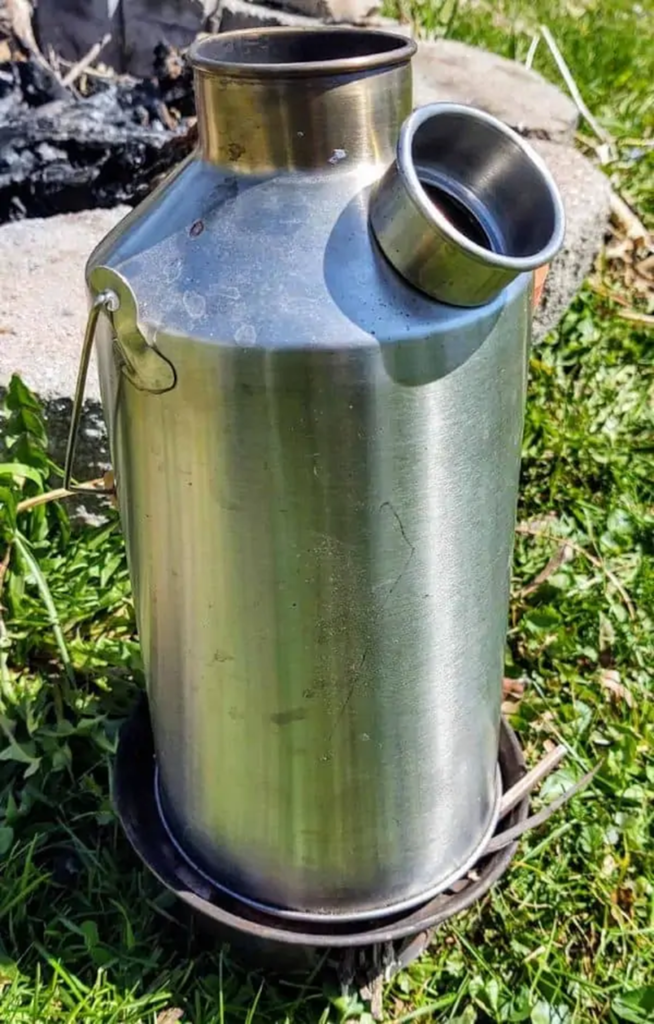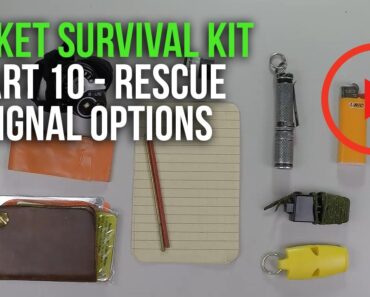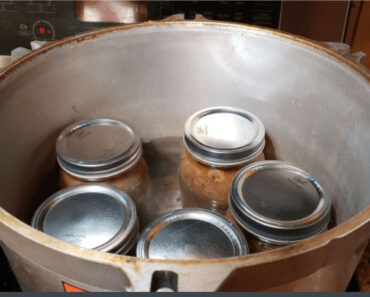The first couple of times that I went through power outages, I used my propane grill for cooking and making coffee. It worked great, until I ran out of fuel.
No big deal, I thought to myself. I’ll just pick up more propane.
Of course, when I got to the store, I realized everyone else in town had the same idea and there was no fuel to be found.
No big deal, I still have a charcoal grill, so I’ll just grab some briquettes.
But there was no charcoal, either.
This was the moment I decided to get into rocket stoves.
I had heard about rocket stoves for years but had never really looked into them. I knew that you could buy them, but what I really wanted to do was make one. And I did, very cheaply, which I will get into later on in the article.
But at this point, you may be asking yourself a few questions:
- What is a rocket stove?
- How does it work?
- Why would I want one?
- Are there different ways to make one?
The answers to those questions is exactly what this article is about, as well as providing you with multiple different rocket stove materials and options for buying one.
Remember to stick around to the end to find out how to make one of the cheapest rocket stoves around.
What is a Rocket Stove and How Does it Work?
A rocket stove is simply a stove that burns biomass very efficiently which results in a much hotter fire. Larry Winiarski developed the rocket stove back in 1980 which was based on a Sam Baldwin design.
Because it’s such a simple, and elegant design that works so well, rocket stoves are used around the world and in third world countries.
Here is what a rocket stove looks like:
The heart of the stove looks like the letter “L.”
The bottom of the “L” is where fuel (biomass) is fed in and it sits on a shelf.
The vertical part of the “L” is the chimney and this is where combustion (the fire) takes place.
Once the fire is going, it pulls a lot of oxygen into the stove through the fuel shelf, and this allows the fire to burn much hotter than a regular stove.
The insulation around the chimney keeps the inside of the chimney very hot and super heats the air, creating a much hotter burning fire.
Why Use a Rocket Stove?
Like any stove, rocket stoves have their pros and cons, but ultimately I prefer them if I’m using an outdoor stove. Here are what I think are the pros and cons of the rocket stove:
Pros
Quick Ignition
A campfire takes time to prepare for and build. However, once a rocket stove is set up and ignited, it doesn’t take long for it to reach a high temperature.
Easy to Extinguish
Because a rocket stove burns so hot and is contained in a small space, it doesn’t take long for it to burn itself out once there is no more fuel.
Reduces Cook Time
Once you get the stove going, you can start cooking your food or boiling your water within minutes.
Fuel Size
Fuel size, or the size of wood you want to burn, is dictated by the size of the rocket stove, and therefore the fuel shelf. These can be as large or as small as you like them to be.
For most people, the smaller rocket stoves are great for general outdoor cooking or emergency situations.
The fuel used for smaller stoves will be things like grass, pinecones, pieces of bark, and small pieces of wood. This means you don’t have to worry about chopping or cutting larger pieces of wood to burn.
Won’t Run Out of Fuel
You won’t run out of fuel as long as there is an abundant source of biomass (twigs, grass, pinecones, bark, small pieces of wood, etc.
Whatever biomass can be shoved into the fuel shelf will burn, this means you don’t have to worry about chopping or cutting wood as long as there is an abundance of small biomass available.
No Smoke
You won’t have to worry about smoke following you around this fire.
Due to the high temperature, combustion is more complete than other stoves that operate at lower temperatures. This results in little to zero smoke.
Cheap to Make
Outdoor stoves can be rather expensive, but with just a few tools, very little materials, and a little bit of elbow grease, you can make a rocket stove cheaply.
Cons
Needs A Lot of Fuel
Rocket stoves burn through fuel quickly, so you will need to make sure you have an abundant amount of biomass ready to go beforehand.
Temperature Regulation
There are no knobs for controlling the temperature, nor can you move a pan to some cooler coals like you can when using a campfire. If the rocket stove becomes too hot for what you are cooking, all you can do is remove the cookware from the chimney and allow the fire to burn down a bit.
Rocket Stove Plans
The rocket stoves below will be split into two categories. The first will be those that you can purchase, followed by some designs that you can make yourself with a variety of materials or even recycled materials.
One thing most of these options leave out over the original design is the insulation around the chimney. However, even without the insulation, these stoves work pretty darn well.
Solo Stove
The Solo stove was my first experience with a commercial “rocket stove,” although I’m not sure I would call it a true rocket stove. It doesn’t have the classic “L” shape, insulation, or a shelf that fuel can be fed through, but it works on the same principle of feeding more oxygen into the fire.
From the outside, the solo stove looks like a simple can. However, like so many things, it’s what’s on the inside that counts.
There are a series of holes around the outside bottom of the can that draw oxygen into the stove.
Biomass is elevated off the interior bottom of stove by a grate.
Once a fire is going, heated air is then redirected up along the sides of the can and out along the top rim. This allows for more complete combustion to take place. Due to its size, the solo stove is meant for relatively short burns – more than long enough to cook a meal – before ash builds up in the bottom.
Check out this article for a more in-depth review of the Solo Stove: Solo Stove Lite Review (2021): Is this A Good Survival Stove?
Kelly Kettle
I think of the Kelly Kettle as less of a rocket stove than the solo stove, even though it looks more like one.
The Kelly Kettle is basically made up of two separate components. The base, where the fire is made and the kettle, which acts like a chimney.
The base is open on the top and it has a hole on the side. Fuel can be placed into the base from the top, and once the fire gets going, the kettle is placed on top of the base. Fuel can then be added via the hole on the side of the base.
When the kettle is placed on top of the base, the heat is contained and directed up through its center, like a chimney. Air is then drawn in through the hole in the base. This provides a steady flow of oxygen, which results in a hotter fire.
I really like the Kelly Kettle as a type of rocket stove because it has some cool features.
Because the base and the kettle are two separate components, you can cook food directly over the base if you want to. The kettle is true to its name because around the chimney, there is a chamber for holding water.
So, when the kettle is placed on top of the base, you can boil water and still have heat coming out of the chimney, allowing you to warm up another drink or to do some outdoor cooking.
Check out this article for a more in-depth review of the Kelly Kettle: Best Survival Stove Reviews: 4 Hands-on Reviews
Marsh Kettles Rocket Stove
The rocket stove offered by Marsh Kettles looks like a great option for anyone looking to purchase a highly portable rocket stove. Their stoves come in couple of different sizes, but what makes it special is that it is easy to take apart and put back together, and no tools are required.
This makes it extremely compact and much easier for anyone wanting to carry a stove in a pack or in their vehicle. It would also make it more convenient to store at home.
This stove has the classic “L” shape of a rocket stove, and the only two things that appear to be missing would be insulation and a shelf for fuel.
This is a stove I hope to have some experience with in the near future because I really like some of its features, it looks durable, and its made in the USA.
To check out the stoves offered by Marsh Kettles, click here.
DIY Rocket Stoves
With a little bit of imagination, tools, and materials you can make a rocket stove exactly like the ones pictured below, or you can alter them slightly to make them your own.
Concrete Rocket Stove
Should you find yourself with a free weekend and an itch to exercise your handyman skills, a concrete rocket stove is relatively easy to make.
Obviously, due to the weight of the material this isn’t a very portable stove, but it would make a fine addition to any backyard or for off-grid cooking.
If I were making this stove, I probably wouldn’t incorporate the shelf for fuel into the concrete itself, just in case the shelf where to ever break. Instead, I would make a grate slightly smaller than the diameter of the fuel chute so that the grate could easily be removed or replaced.
The added benefit of using this material is that the concrete will act as a type of insulation around the chimney, resulting in a hotter fire.
Brick Rocket Stove Plans
If concrete isn’t your thing, another way to make a back yard rocket stove is to use bricks.
The process and skills needed for this option are about the same as the above method, but some people might find brick easier to work with and more aesthetically pleasing.
Cinder Block Rocket Stove
Cinder blocks are a super easy material to use for setting up a type of rocket stove that I have seen a lot of people use.
Of course, if you have several more concrete blocks, and the available space, you can expand the above design into a dual-burner rocket stove.
Heavy Duty Rocket Stove
This option is a heavy duty rocket stove that will require some metal cutting, possibly an angle grinder, and welding skills. The stove plans call for heavy duty square tubular steel to be uses as the stove frame. While this stove design isn’t overly complicated, I would rate it as a slightly more advanced DIY project, given the tools and skills needed to complete it.
As you can see, the stove has the classic “L” shape with the addition of a forty-five degree chute. When wood is packed into the angled shoot, it acts like a self-feeding stove for a short period of time and the bottom of the “L” will draw in additional oxygen.
Adding a grill rack to the top of the stove makes this heavy duty stove a great option to cook food on during long camping trips or as rocket grill placed in a permanent location.
Clay Dirt Rocket Stove
People having been making fireplaces and stoves out of clay for a long time, so it is a tried-and-true natural building material.
Clay is easy to work with, abundant in some locations, and it is quite durable once it is dry.
Like the previous two options, a clay rocket stove won’t be very portable, but it will provide a very functional, natural-looking stove to a backyard. It can also be built at an off-grid location where other building materials may be hard to come by.
Wood Rocket Stove
Have you got a decent size log and some drill bits? If you do, then you can make another natural rocket stove out of wood.
At this point, you probably have the “L” shape design of a rocket stove seared into your brain, which is good, because that will help you to create this stove.
The first thing you need is take a small log and stand it up on its end. Then place the drill bit in the center of the top of the log. Drill a hole about halfway – or a little more than halfway – down the length of the log. This hole will be the chimney.
Next, take your drill bit and drill another hole into the side of the log so that it intersects with the vertical hole that was drilled from the top. This side hole will be the fuel chute and it can be horizontal, or it can have a slight upward angle.
The only thing left to do is to create a small, elevated surface on top for the cookware. This can be done by pounding a few nails around the opening of the chimney or by placing a few small rocks around the opening.
DIY Rocket Stove
With just a couple of soup cans, a few tools, and a little bit of your time, you can easily make your own rocket stove. I made the rocket stove pictured above about a year ago and it lasted me about that long.
It would have lasted me longer, but I didn’t use any kind of protective coating on it, nor did I take very good care of it. By spraying the cans with a protective coating and not leaving it out in the rain (duh), I’m sure I would still be using this stove today.
Also, there is one thing that I forgot to do when making this stove, and that is I didn’t put any insulation material around the chimney. The stove worked great without insulation, but I think it would have worked even better if I had added it.
If you would like to try your hand at making your own rocket stove, click the link at the bottom of this section for the full and easy-to-follow walkthrough.
Just so you know before checking out the link, here are all the items I used for making the soup can rocket stove:
- 1 38oz aluminum can
- 1 28oz aluminum can
- 2 14oz aluminum cans
- Tin snips (a Dremel or rotary tool would be best)
- Safety glasses
- Gloves
- Permanent marker
- Metal file
- Power Drill or awl
- Metal wire (optional if you do not want a carrying handle)
- Pliers
- Tape measure
For an in-depth look and detailed instructions on how to make your own rocket stove , click the following link, How To Make a DIY Rocket Stove: A 16 Step Walkthrough Guide
FAQs
What can you burn in rocket stoves?
Pretty much any kind of biomass can be burned in a rocket stove. This includes, grass, pinecones, tree bark, small pieces of wood, fuel pellets, and even charcoal.
Can a rocket stove be used indoors?
The rocket stoves discussed in this article aren’t intended for indoor use, but there is one kind of rocket stove that can be used indoors, which will be answered in the following question.
Can a rocket stove heat a house?
The rocket stoves described in the above article are not suited for indoor use. However, there is a kind of stove called a rocket mass heater that can be used to heat a home.
Its design is a little bit different than the rocket stoves in this article, but it uses the sample principle of heating. Since it has a proper ventilation system, it can safely be used indoors.
Additionally, these types of stoves work so well that many people report a huge reduction in the amount of fuel they need to burn.
Are rocket stoves difficult to clean?
Not at all. If the stove is small and portable, like the first three options discussed in the above article, I wait until the fire has gone out, the stove is cold to the touch, and simply dump the ashes out.
If the rocket stove is larger and a more permanent fixture, you will need a small shovel or brush to remove the cold ashes once they build up.
How do you start a fire in a rocket stove?
Everyone has their own way of starting a fire in a rocket stove, but here is what I like to do:
First, I put some fuel on the shelf and as well as a few pieces of fuel in the chimney.
Then I grab a piece of fatwood, or something other fire-starting aid, light the end of it, and place it either into the chimney or on the shelf.
Final Thoughts
For me, a rocket stove is a must-have outdoor stove. It’s a great piece of gear for outdoorsman because they are lightweight and compact, which makes them highly portable. Setting a rocket stove up and getting it to temperature is quick, so you don’t have to wait long to cook a meal or boil a cup of water. And since they are so easy to extinguish, you don’t have to worry so much about leaving a firepit that could potentially reignite.
Even if a rocket stove isn’t the main stove you want to use, it’s a good idea to have a small one in your survival kit.
However, a rocket stove is also wonderful to have at home for cooking during normal times, or to be used as an alternative cooking stove during an emergency. As long as you have a source of biomass, then you don’t have to worry about running to the store to get more fuel or to find the fuel shelves empty.
Whether you purchase a rocket stove or make your own, I think you will be pleasantly surprised by how well this simple design works. And if you add one of these stoves to your toolbox sooner rather than later, you will thankful to have it during a power outage or disaster.
Thanks for reading, and stay prepared.






















![[VIDEO] – Transforming an LMTV into the Ultimate Bugout Overlander – Part 3 [VIDEO] – Transforming an LMTV into the Ultimate Bugout Overlander – Part 3](https://survivalcove.com/wp-content/uploads/2022/11/article-thum-lmtv_edited-370x297.jpg)
























